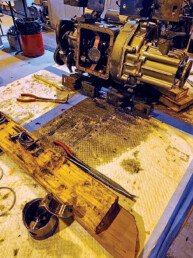I spent far too much time in 2017 applying toxic marine products to my boat. On sunny, breezy summer days, it was hard to avoid feeling like the best part of the season had escaped me: respirator strapped on, I felt like Darth Vader on a lonesome death star, rather than the cruiser I longed to be.

At first I pretended I was sailing the Gulf Islands, instead of wooding down the black crud invading my brightwork. Days later, while brushing on the third coat of varnish, I imagined the crowd who would admire its gleam at the Port Townsend Wooden Boat Festival. By the fifth work session, I was thoroughly sick of boats, brushes and paint cans. Days later, when the final coat of varnish went on, I must have lost enough brain cells to achieve a level of peace with the process; at any rate, I was able to put the experience in perspective, acknowledging that, thanks to the following rules, it wasn’t so hard to get the work done, after all.

It’s all about preparation. Varnishing on the spur of the moment can be done—but I’ve learned that the product is generally as good as the plan. That’s why I started by getting organized, sorting my supplies into boxes to keep at hand and always holding on to extra materials, just in case. Looking back, I spent more time cleaning, sanding, taping, and waiting for the right weather than I did applying products. After each step, I craned my neck under the thwart and around the mast step, ensuring that everything was thoroughly sanded, cleaned, taped, and ready.
Be neat. I clean up a lot. Messy work areas produce messy results. That applies to garb, too. Decent clothes are a priority when I varnish or paint, since ratty things drag through the paint and affect my mental approach to the work. If I feel like it’s ok to wipe my hands on my shirt sleeve, or use it to mop up a run, then that sleeve and the goop on it invariably creates a mess elsewhere. Neat clothes makes my work neater.
I used to wear gloves, but no more. They’re awkward and keep me from really feeling the brush.
Create structure and order. Every tool and product gets an assigned spot before, during, and after the job. I move about the boat in a specific order, depending on the project: top to bottom, left to right, clockwise, etc. Having a system ensures that each phase of the job is done right, and I’m never mixed up about whether I’ve already varnished a section. Because my structure makes equipment easy to find, my projects don’t usually develop unexpected snags at inconvenient times.
Relax. Boating is supposed to be fun. If I’m uptight and tense when applying varnish, I find myself putting it on too thin, or I end up with runs I didn’t notice. I’d rather be off the water for a few extra days than rush a varnish job when I’m not in the mood. The last thing I want to think about in the middle of the job is whether I’m almost done or not. (There’s a reason I have two boats; if I really have the urge, I can get out on the water in one, instead of stressing out about the other’s maintenance needs.)

Still, as I methodically clean, sand, tape, and varnish, I remind myself that maintenance is as much a part of sailing as grocery shopping is a part of everyday life. And I’ve also come to recognize that, whether navigating the shoals off Bainbridge Island or the rougher waters of life, my boat work rules apply. As January arrives, and I consider resolutions for the new year, I’m going to try to remember to stay prepared, organized and relaxed in 2018.
Bruce Bateau
Bruce Bateau sails and rows traditional boats with a modern twist in Portland, Ore. His stories and adventures can be found at www.terrapintales.wordpress.com






